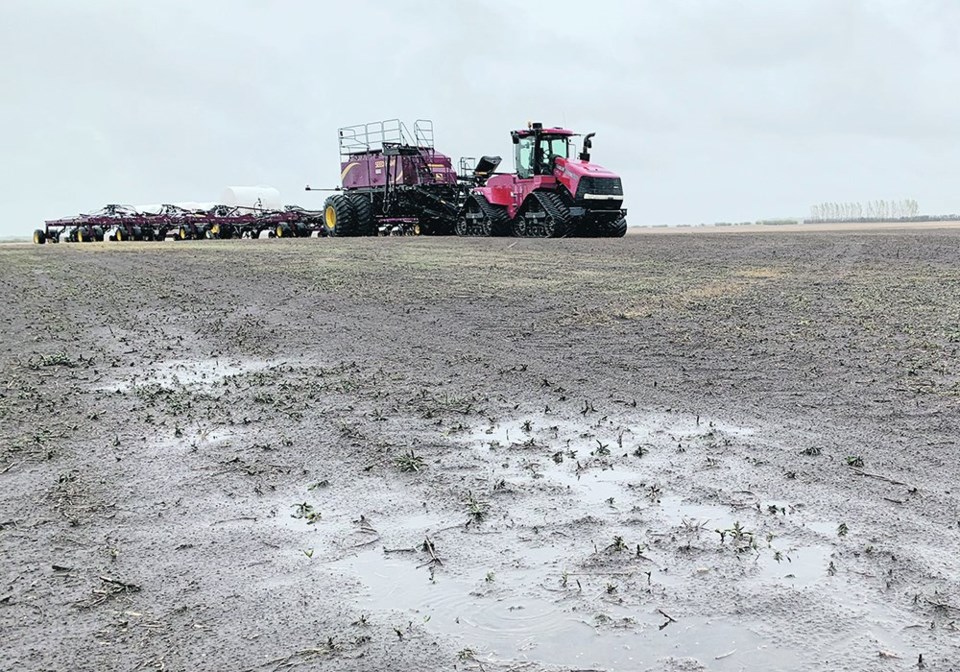WESTERN PRODUCER — It isn’t time to abandon all hope of getting a crop in the ground in the waterlogged regions of the eastern Canadian Prairies but that time is quickly approaching for some, says an analyst.
“Delays are getting serious here,” said MarketsFarm analyst Bruce Burnett.
Seeding is two to two-and-a-half weeks behind normal in many areas of eastern Saskatchewan and Manitoba.
We’re going to plant the crop late and that’s a concern. There’s a lot of areas that are flooded right now,” he said.
In years that began with similar soggy conditions, two to four million acres went unseeded in the eastern Prairies.
IBurnett doesn’t think the situation is that dire yet at this point in the spring.
It would take a lot more rain over the next three weeks in order for us to move substantially more acres into the abandonment category,” he said.
“I don’t think we’re that inundated right now, (although) in some areas they are. The Red River Valley is under a few feet of water.”
The next three weeks is going to be critical in determining the outcome of this year’s seeding campaign.
With prices at sky-high levels growers are going to do everything it takes to seed a crop, he said.
The other big concern is the lingering dryness in many areas of the western Prairies where farmers are desperate for rain.
“Very few farmers have the Goldilocks scenario right now. A lot of them are either too wet or too dry,” he said.
It is a similar situation south of the border where spring wheat seeding is way behind normal in the United States.
Farmers in Minnesota had planted five percent of their intended acres of the crop as of May 15, compared to the average of 75 percent. Growers in North Dakota seeded 17 percent versus the normal of 60 percent.
Jim Peterson, policy and marketing director with the North Dakota Wheat Commission, estimates that seeding is 10 days to two weeks behind in the wet areas of his state.
Much of eastern North Dakota and western Minnesota are waterlogged. Those two states account for 58 percent of U.S. spring wheat acres with Montana making up another 27 percent.
In a normal year, many farmers in those high-moisture areas would be seriously considering switching to later season crops like soybeans or sunflowers or even fallowing the land as crop insurance deadlines loom.
Over one million acres of spring wheat was lost between the March intentions report and the final June plantings report in 2011 and 2013, two previous years where seeding was delayed.
But this is far from a normal year with Minneapolis spring wheat futures exceeding US$13 per bushel.
Peterson thinks many farmers may willingly accept reduced crop insurance yield coverage and exceed the deadlines for getting their wheat planted.
Farmers told the U.S. Department of Agriculture back in March that they intend to plant 11.2 million acres of spring wheat, a two percent drop from last year.
Some growers in western North Dakota and Montana likely decided to increase their acres since that report was released because there has been an easing of drought conditions.
But some in eastern North Dakota and western Minnesota may be making the switch to other crops, so acres could balance out and end up close to the USDA’s forecast.
However, he doesn’t think growers will plant the 1.92 million acres of durum they were intending to grow back in March due to the wet conditions and the lack of price appreciation for that crop compared to spring wheat over the past couple of months.
Conventional wisdom suggests spring wheat and durum yields could be compromised by a late start to the season because the crops may still be in the reproductive phase when the heat hits in the last half of July. There could also be potential damage from an early frost.
However, a yield reduction has only happened once in the last five late-planting years, said Peterson. In some of the other years the yields were fantastic due to the good moisture profile to start the season.
So it is premature to be forecasting any production losses for U.S. spring wheat based on reduced acres and yields because neither of those factors may come to pass.
Contact [email protected]

